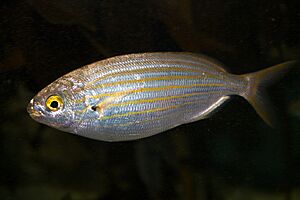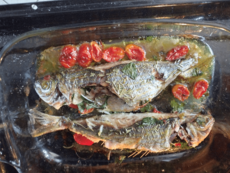Salema porgy facts for kids
Quick facts for kids Salema porgy |
|
|---|---|
 |
|
| Conservation status | |
| Scientific classification | |
| Synonyms | |
|
Genus synonymy
Species synonymy
|
The salema porgy (Sarpa salpa), also called the dreamfish, is a fascinating type of ray-finned fish. It belongs to the family called Sparidae, which includes other seabreams and porgies. This fish is the only species in its special group, the Sarpa genus. You can find it in the eastern Atlantic Ocean, the Mediterranean Sea, and the southwestern Indian Ocean. Sometimes, eating this fish can make people feel strange or sick, especially if it has eaten certain things.
Contents
About the Salema Porgy
How Scientists Name It
The salema porgy was first officially described in 1758 by a famous scientist named Carl Linnaeus. He gave it the name Sparus salpa. Later, in 1831, another scientist, Charles Lucien Bonaparte, placed it in its own unique group, the Sarpa genus. Scientists use these names to organize and understand all the different living things on Earth.
What Does It Look Like?
The salema porgy has a body that is a bit thin and nicely oval-shaped. Its dorsal fin (the one on its back) has 11 strong spines and 14 or 15 soft rays. The anal fin (on its belly) has 3 spines and 13 to 15 soft rays.
It has scales on its cheeks, just under its eyes. However, some parts, like the area between its eyes, are smooth without scales. The fish has a single row of special incisor-like teeth on its upper jaw. Its lower jaw also has pointed, incisor-like teeth. It does not have any flat, molar-like teeth for grinding food.
The body of the salema porgy is shiny and silver. It has between 8 and 10 golden lines running horizontally along its sides. You can also spot a small black mark at the base of its pectoral fin (the fin near its gills).
Males are usually about 15 to 30 cm (6–12 in) long. Females are typically larger, growing to about 31 to 45 cm (12–18 in). The biggest salema porgy ever found was about 51 cm (20 in) long!
Where Does It Live?
You can find the salema porgy in the eastern Atlantic Ocean, stretching from the Bay of Biscay all the way down to South Africa. It also lives throughout the Mediterranean Sea. Sometimes, it even swims as far north as Great Britain. This fish is quite common and usually lives near the surface, but it can be found as deep as 70 m (230 ft).
What Does It Eat and How Does It Reproduce?
Salema porgies are mostly vegetarians. They love to eat plants! One study in Libya showed that their main food was sea grass, followed by algae. They sometimes eat small crustaceans too. Near Corsica, adult salema porgies mostly eat a type of seagrass called Posidonia oceanica and the tiny plants that grow on it. Young salema porgies, however, prefer to eat tiny floating organisms called plankton.
Reproduction and Life Cycle
Off the coast of South Africa, these fish lay their eggs between April and September. They also travel each year between special nursery areas in the Eastern and Western Cape to KwaZulu-Natal.
Interestingly, the salema porgy is a protandrous hermaphrodite. This means that most of these fish are born male. As they get older, they change into females! In the northern parts of the world, like the Canary Islands, they lay eggs from September to March. Off the coast of Italy, fish change from male to female when they are between 24 and 31 cm (9.4 and 12.2 in) long. This usually happens when they are 3 to 7 years old. Most fish become able to reproduce when they are about 19.5 cm (7.7 in) long, and at this size, most are still males. In this area, they have two main times for laying eggs: once in the spring (March to May) and again in the autumn (late September to November).
Is It Safe to Eat?
Because salema porgies eat mostly plants, they are very hard to catch with a fishing rod. Their size and where they live also make them difficult to catch with nets or harpoons. This is why you don't often see this fish for sale. It is mainly eaten in places like France, Israel, and Tunisia.
Sometimes, eating Sarpa salpa can cause strange effects, like vivid dreams or hallucinations. This is called ichthyoallyeinotoxism. In the past, people in the Pacific Ocean, like the Melanesians and Polynesians, used these effects in some of their traditions. Similar uses were also mentioned in the Mediterranean during the time of the Roman Empire.
Scientists have studied salema porgies from the Mediterranean Sea and found that they can sometimes be unsafe to eat, especially their insides. The fish are not always toxic. They only become unsafe during certain times of the year. This makes scientists think that toxins from certain algae or phytoplankton (tiny water plants) that the fish eat might be the cause. When these tiny plants bloom, they can make the fish toxic.
Since a type of algae called Caulerpa taxifolia accidentally came into the Mediterranean, salema porgies have started to collect toxins from this algae in their bodies. Because of this, it's a good idea to clean the fish right after it's caught if you plan to eat it.
What Else Does It Eat?
The salema porgy is a plant-eating fish. In 2014, in Portugal, there were so many salema porgies that they ate too much of the local seagrass. Scientists tested three different types of seagrass to see which ones the fish preferred. They found that the fish liked Zostera noltii the most. So, if people want to restore seagrass in areas with many salema porgies, they should plant Cymodocea nodosa and Zostera marina. This way, the fish will have food, but they won't eat all the new plants.



